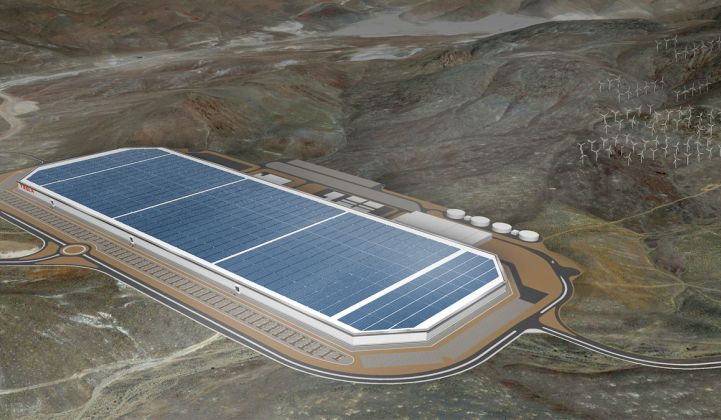Tesla might be skipping the madhouse of the Consumer Electronics Show in Las Vegas this week, but the electric car maker and its Japanese battery manufacturing partner Panasonic still made some big news at the tech conference.
On Wednesday morning, Panasonic’s North American CEO Joseph Taylor told a packed room of reporters that Tesla and Panasonic have now officially started making batteries at the Gigafactory, about 450 miles away from Vegas just outside of Reno, Nevada.
The “high energy density” lithium-ion batteries will go into battery farms first, said Taylor, followed by being used in the Model 3, which is Tesla’s upcoming $35,000 electric car that’s supposed to ship toward the end of this year. Taylor said the official start of commercial production at the Gigafactory “further deepens the strategic relationship with Tesla.”
At the same time, Tesla released a blog post this morning on the accomplishment, offering up more details of the features of the new batteries that are now being made at the factory.
While the news might seem like the latest way for Tesla to toot its own horn, it’s actually a big deal for both Tesla and Panasonic.
One reason is that it’s crucial for Tesla to use these new batteries -- which are slightly larger size in size than the ones it has been using -- in order to lower battery costs for the Model 3 by 30 percent. At $35,000, the Model 3 is Tesla’s lowest-cost car to date. To hit that price, the company needs to lower its costs at all levels, but in particular the cost of its battery packs, which are one of the most expensive components of the all-electric vehicle.
The new batteries Tesla and Panasonic are making are called 2170 battery cells, so-called because the batteries are 21 millimeters in diameter and 70 millimeters in length. Previously, Tesla had been using Panasonic’s 18-650 battery cells (18 millimeters in diameter, 65 millimeters in length).
The new, bigger batteries hold more raw materials than the former ones and thus store more energy and produce more power. Tesla can get the same (or more) range for its cars and potentially use fewer battery cells.
It’s basically a more efficient form factor, the design and engineering is meant to optimize costs. When manufacturing these batteries at large scale -- Tesla says it wants to make enough batteries for 500,000 cars a year -- the savings could really add up.
These batteries were jointly designed by both Panasonic and Tesla, which continues the companies’ highly unique partnership. At an event at the Gigafactory last summer, Panasonic’s executive vice president Yoshihiko Yamada described the companies’ relationship as a completely new type of business partnership. Both companies are investing heavily in the infrastructure of the Gigafactory.
As the companies ramp up production of the batteries, both companies will be hiring many more engineers and factory workers. At peak production the Gigafactory is meant to directly employ 6,500 people, and Tesla says it will create 20,000 to 30,000 additional jobs in the surrounding area.
Tesla is just announcing battery production now, but the company started making the batteries at least back in December. Tesla and SolarCity’s solar and battery farm on the Hawaiian island of Kauai was one of the first places to get these new 2170 battery cells made at the Gigafactory.
I visited that solar and battery farm, which provides power for the island’s utility Kauai Island Utility Cooperative, last month on the day the first batteries were being installed. The 2170 batteries are also being used for a battery farm that will be built for Southern California Edison.
That these batteries are already in the process of being installed on the grid shows that the companies making them and the utilities using them have a high degree of confidence that these batteries will operate reliably, despite the new form factor. That could indicate that Tesla and Panasonic have been making these batteries for awhile in pilot and test phases.
For Panasonic, reaching commercial operation at the Gigafactory is an important milestone for the company’s goal to grow its battery production considerably outside of the consumer electronics industry. At CES, the company said the automotive division was now the largest part of Panasonic North America.
At the end of the day, the news is also an important validation for what Tesla and Panasonic are trying to do in Nevada. They said they planned to make these batteries by the end of 2016 and now they are. In a world where electric car companies seem to be prone to making unsubstantiated claims, meeting goals is a good thing for the future of electric vehicles.



